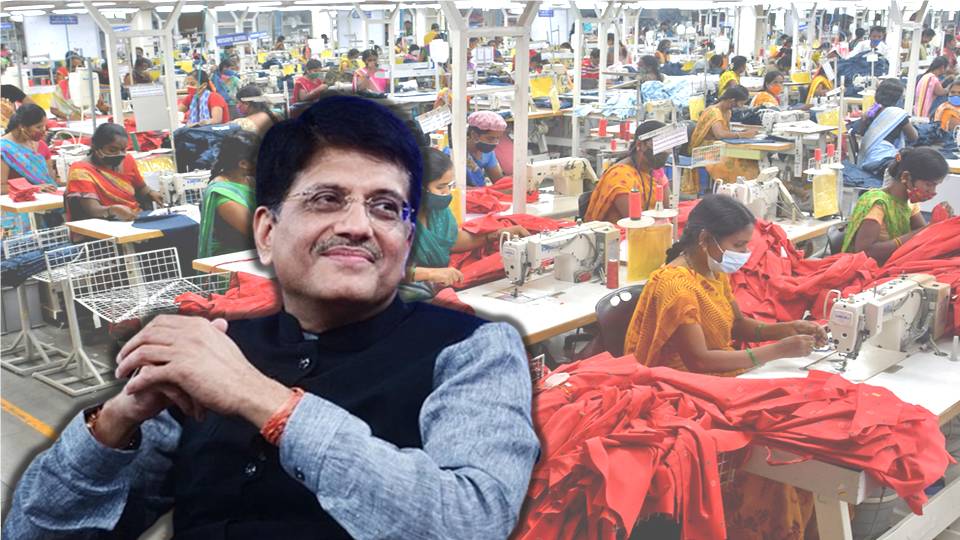Production Linked Incentive (PLI) scheme has become one of the key factors in expanding the domestic industry in India. Under the Atmanirbhar Bharat Mission, Finance Minister, Nirmala Sitharaman announced an outlay of INR 1.97 Lakh Crores for the 14 key sectors to create a manufacturing industry in India. With the aim to enhance India’s manufacturing and export capabilities, the Textile industry was one of the 14 key sectors approved under the PLI scheme. Lacking behind the Bangladeshi apparel industry, the Indian textile industry will have an edge in the form of the PLI scheme.
PLI for the textile industry
On the inauguration occasion of SIMA (Southern India Mills Association) Texfair expo in Coimbatore (Tamil Nadu), Union Minister Piyush Goyal said that “we are keen to support the apparel manufacturing sector and we are considering coming out with another PLI scheme”.
“Centre would help the Coimbatore-based South India Textiles Research Association SITRA’s efforts to manufacture quality uniforms for the defence personnel under the National Technical Textile Mission,” he added.
His statement to launch another PLI scheme for the apparel manufacturing sector aligns with the success of the earlier one. INR 10,683 crore had been allotted for the implementation of the PLI scheme for the textile industry in 2020.
The scheme was divided into two parts, in Part 1 the minimum investment of INR 300 and a minimum turnover of INR 600 crore are required to get incentives: and in Part 2, the minimum investment of INR 100 crore and minimum turnover required INR 200 crore to get incentives.
The reason for the launch of PLI 2.0 is that the lower input cost of the Bangladeshi apparel industry has dominated the market and to give competition, the government has to bring systematic reform and a more lucrative incentive approach has to be adopted.
So, the government wants to lower the threshold of minimum investment requirement to avail of the incentives as well as include knitted fabrics besides man-made fibre and technical textiles in PLI 2.0 in the textile sector.
Read More: Under the PLI scheme, Samsung and Apple will boost the Indian manufacturing sector
Strategy to eliminate Bangladeshi clothes from the market
Since the time when Bangladesh was a part of Akhand Bharat, the region has been traditionally famous for its muslin, silk, and cotton clothing. Building on the transitional expertise, the government also adopted systematic policy reform and brought the country to the level that the textile products form about 90% of the overall value of its global shipments. Low labour cost, weaker local currency, and traditional expertise have given the industry an edge in the world apparel export market.
Currently, the domestic apparel & textile industry in India contributes 5% of the country’s GDP and India is the 6th largest textile exporter in the world. The industry supports direct and indirect employment for about 45 million people in India.
Read More: PLI scheme in the Auto Sector will now generate 7.5 lacs skill-based jobs
Similar to Bangladesh, India has the leverage of cheap input costs and huge availability of raw materials. The aim would be to materialize its potential on the ground. Earlier announced PLI scheme for the textile industry had set a very big investment threshold to avail the incentives.
Most of the apparel industries are micro, small and medium enterprises and their capability to invest such a large sum of money is not susistaible for their buisnesses. INR 100 to 200 crore investment threshold to avail benefit under PLI excluded many of them and somewhat limited the expansion of the scheme.
But, according to the latest update about the PLI 2.0, the scheme will reduce the threshold from earlier INR 100 crore to 2 crores and besides manmade fibre & technical textiles, knitted fabrics products have also been included. This will expand the market and will include a lot of MSMEs who were earlier excluded from the benefit of PLI 1.0.
The inclusion of huge MSMEs and utilization of incentives under the scheme will reduce the input cost of products and will make them competitive in the market. In a way, with the leverage on which the Bangladeshi apparel industry plays, India too will have the same kind of benefit. The huge domestic market in India will further give an added advantage to India-made clothes and will systematically eliminate Bangladeshi competition.
Support TFI:
Support us to strengthen the ‘Right’ ideology of cultural nationalism by purchasing the best quality garments from TFI-STORE.COM.
Also Watch:
